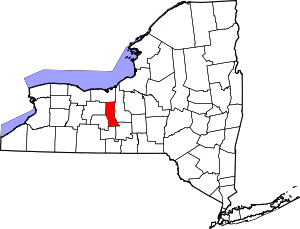Lodi (village), New York
| Lodi, New York | |
|---|---|
| Village | |
 Lodi, New York Location within the state of New York | |
| Coordinates: 42°36′48″N 76°49′27″W / 42.61333°N 76.82417°WCoordinates: 42°36′48″N 76°49′27″W / 42.61333°N 76.82417°W | |
| Country | United States |
| State | New York |
| County | Seneca |
| Area | |
| • Total | 0.6 sq mi (1.5 km2) |
| • Land | 0.6 sq mi (1.5 km2) |
| • Water | 0.0 sq mi (0.0 km2) |
| Elevation | 1,106 ft (337 m) |
| Population (2000) | |
| • Total | 338 |
| • Density | 595.4/sq mi (229.9/km2) |
| Time zone | Eastern (EST) (UTC-5) |
| • Summer (DST) | EDT (UTC-4) |
| ZIP code | 14860 |
| Area code(s) | 607 |
| FIPS code | 36-43214 |
| GNIS feature ID | 0974039 |
Lodi is a village in Seneca County, New York, USA. The population was 338 at the 2000 census.
The Village of Lodi is in the north part of the Town of Lodi and is northwest of Ithaca, New York. It owes its name to the Italian city of Lodi.
Lodi Point State Park is west of the village on the shore of Seneca Lake.
History
This part of New York was in the territory of the Seneca tribe until the Sullivan Expedition drove them away. The area was then assigned to the Central New York Military Tract used to pay soldiers for service in the American Revolution. The Lodi Methodist Church, designed by noted church architect Warren H. Hayes (1847–1899), was listed on the National Register of Historic Places in 1982.[1]
Geography
Lodi is located at 42°36′48″N 76°49′27″W / 42.613366°N 76.824082°W (42.613366, -76.824082).[2]
According to the United States Census Bureau, the village has a total area of 0.6 square miles (1.5 km2).None of the area is covered with water.
Lodi is in the Finger Lakes District of New York.
New York State Route 96A and New York State Route 414 intersect at the village.
Demographics
As of the census[3] of 2000, there were 338 people, 119 households, and 84 families residing in the village. The population density was 595.4 people per square mile (229.0/km2). There were 138 housing units at an average density of 243.1 per square mile (93.5/km2). The racial makeup of the village was 94.38% White, 0.89% Black or African American, 0.59% Native American, 2.07% from other races, and 2.07% from two or more races. Hispanic or Latino of any race were 3.85% of the population.
There were 119 households out of which 40.3% had children under the age of 18 living with them, 48.7% were married couples living together, 15.1% had a female householder with no husband present, and 29.4% were non-families. 20.2% of all households were made up of individuals and 11.8% had someone living alone who was 65 years of age or older. The average household size was 2.84 and the average family size was 3.23.
In the village the population was spread out with 32.5% under the age of 18, 3.8% from 18 to 24, 33.1% from 25 to 44, 17.2% from 45 to 64, and 13.3% who were 65 years of age or older. The median age was 34 years. For every 100 females there were 104.8 males. For every 100 females age 18 and over, there were 100.0 males.
The median income for a household in the village was $30,625, and the median income for a family was $34,375. Males had a median income of $29,375 versus $20,938 for females. The per capita income for the village was $13,709. About 18.1% of families and 30.3% of the population were below the poverty line, including 43.3% of those under age 18 and 17.8% of those age 65 or over.
References
- ↑ "National Register Information System". National Register of Historic Places. National Park Service. 2009-03-13.
- ↑ "US Gazetteer files: 2010, 2000, and 1990". United States Census Bureau. 2011-02-12. Retrieved 2011-04-23.
- ↑ "American FactFinder". United States Census Bureau. Retrieved 2008-01-31.
External links
| |||||||||||||||||||||||||||||||||
